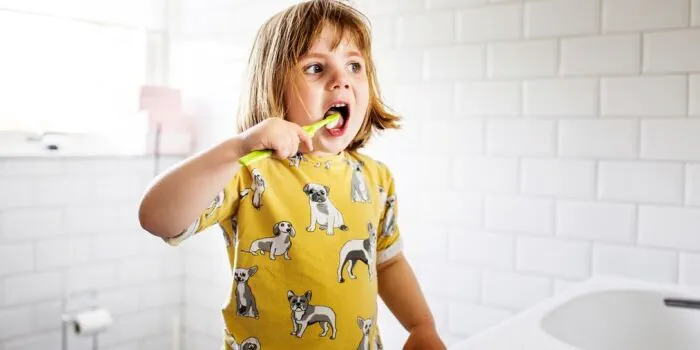Children’s dental emergency? Follow our five-step checklist
Children often get little bumps and bruises when they’re busy running around. So, you’re probably used to patching up minor cuts and grazes. But what should you do if your little one starts complaining of a toothache? Trips and cracks a tooth? Or knocks one out completely? Here, I’ll share a step-by-step guide to help you handle a child’s dental emergency with confidence.

First, it’s a good idea to plan so you’re prepared to act quickly if your child does have a dental emergency. The following tips will help you get ready.
- Register your child with a dentist – even if they haven’t started teething yet.
- Save your dentist’s contact details in your phone in case of an emergency.
- Make a note of your dentist’s arrangements for out-of-hours emergency child dental services.
- Put together a dental first aid kit that includes gauze, a container with a lid, saline solution and a cold compress.
- Organize regular exams with the dentist so any potential issues are dealt with before they become a bigger problem.
If you do need emergency dental treatment for your child, here’s what to do.
Step 1: Review
The first thing you need to do is review the severity of the situation. Check your child over thoroughly and assess how badly they’ve hurt themselves. If a blow to the face or bump to the head has damaged their tooth, call NHS 111 for advice. It might be best to take them to A&E and have them checked out properly – just to be on the safe side.
Step 2: Ring
If your child’s tooth has been knocked out, chipped or broken – but they haven’t been seriously injured – call your dentist immediately and explain what’s happened. Your dental team will do their best to arrange an emergency dental appointment for your child as soon as possible. They’ll also be able to give you advice for looking after your little one at home until your appointment.
If you can’t get hold of your dentist, call NHS 111 for advice. Don’t call your GP, as they don’t provide dental care.
Step 3: Relieve
Next, try to ease your child’s pain and make them comfortable until you can see your dentist. You can give them child-friendly over-the-counter painkillers. Just remember to check the label first and stick to the recommended dosage.
If your child’s mouth is bleeding, get them to bite down gently on a clean piece of cloth or gauze until it stops. If their mouth is swollen, place a cold compress on their cheek or jaw to help.
Step 4: Retrieve
After that, try and find your child’s missing tooth (or pieces of tooth). Acting quickly, preserving the tooth and bringing it to your dentist will give you the best chance of saving it.
If one of your child’s permanent teeth has fallen out, pick it up without touching the sensitive nerve root. Use water to rinse off any dirt and – if your child is willing – place the tooth back into its socket. Get your child to gently bite down on a piece of cloth to hold the tooth in place until you see the dentist. If this is tricky, place the tooth in a sealed container of milk or salty water and take it to your dentist. If you don’t have these, try to get your little one to hold the tooth between their cheek and gums.
If your child has only lost part of their tooth, you should also try to find it and take it to the dentist in a pot of milk or water.
If your child’s baby tooth has been knocked out, or you think the tooth is badly damaged and beyond repair, try to locate it anyway. A baby tooth won’t be replaced, but your dentist will be able to decide whether a damaged tooth can be saved.
If you can’t find your child’s missing tooth or tooth fragments, it’s possible they could have inhaled or swallowed them. If this happens, seek medical attention as soon as possible.
Step 5: Reassure
Lastly, remember to stay calm and confident and set a good example for your little one. They may be scared, upset, or in pain and will look to you for support. So even if you’re worried, try to remain positive and reassure your child.
We now offer GP appointments for children under 18. Find out more about our Under 18 GP Service, call us on 0330 822 3072.
-
Sources Sources
- Dental care for mother and baby. Oral Health Foundation. dentalhealth.org, accessed February 2025
- What are tooth preservation kits? Nemours Children’s Health. Kidshealth.org, accessed February 2025
- Patient information leaflet: Dental trauma guide. British Endodontic Society. britishendodonticsociety.org, published 2022
- What to do about teeth injuries. Nemours Children’s Health. Kidshealth.org, reviewed November 2024
- What should you know about dental injuries of primary teeth? International Association of Dental Trauma. iadt-dentaltrauma.org, accessed February 2025
- Dental recovery plan: everything you need to know. Department of Health and Social Care Media Centre. healthmedia.blog.gov.uk, published February 2024
- Dental trauma in children. Kings College Hospital NHS Foundation Trust. kch.nhs.uk, published August 2022
- Knocked out teeth. Oral Health Foundation. dentalhealth.org, accessed February 2025
- Dental emergencies. American Dental Association. mouthhealthy.org, accessed February 2025
About our health information
At Bupa we produce a wealth of free health information for you and your family. This is because we believe that trustworthy information is essential in helping you make better decisions about your health and wellbeing.
Our information has been awarded the PIF TICK for trustworthy health information. It also follows the principles of the The Information Standard.

More mental health and wellbeing articles
Did you find our advice helpful?
We’d love to hear what you think. Our short survey takes just a few minutes to complete and helps us to keep improving our healthy lifestyle articles.
Legal disclaimer
This information was published by Bupa's Health Content Team and is based on reputable sources of medical evidence. It has been reviewed by appropriate medical or clinical professionals and deemed accurate on the date of review. Photos are only for illustrative purposes and do not reflect every presentation of a condition.
Any information about a treatment or procedure is generic, and does not necessarily describe that treatment or procedure as delivered by Bupa or its associated providers.
The information contained on this page and in any third party websites referred to on this page is not intended nor implied to be a substitute for professional medical advice nor is it intended to be for medical diagnosis or treatment. Third party websites are not owned or controlled by Bupa and any individual may be able to access and post messages on them. Bupa is not responsible for the content or availability of these third party websites. We do not accept advertising on this page.







